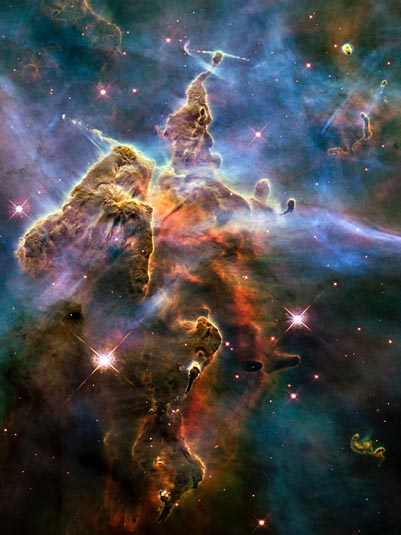
in the Carina Nebula
Carina Nebula Star-forming Pillars & Herbig-Haro Objects with Jets
RA 10h 44m 05s.25 Dec. -59° 29' 45".00
Carina
7,500 light-years (2,300 parsecs)
84 arcseconds (3.1 light-years or 0.94 parsec) wide.
NASA, ESA, and M. Livio and the Hubble 20th Anniversary Team (STScI)
April 22, 2010
Details: Closeup Comparison WideView
Other: 2000 2007 2009a 2009b 2010 2011a 2011b 2012a 2012b 2018
ABOUT THIS IMAGE:
These two images of a three-light-year-high pillar of star birth demonstrate how observations taken in visible and infrared light by NASA's Hubble Space Telescope reveal dramatically different and complementary views of an object. The pair of images demonstrate how Hubble's new panchromatic view of the universe shows striking differences between visible and infrared wavelengths. This turbulent cosmic pinnacle lies within a tempestuous stellar nursery called the Carina Nebula, located 7,500 light-years away in the southern constellation Carina.
The visible-light view shows how scorching radiation and fast winds (streams of charged particles) from super-hot newborn stars in the nebula are shaping and compressing the pillar, causing new stars to form within it. Infant stars buried inside it fire off jets of gas that can be seen streaming from towering peaks. Streamers of hot ionized gas can be seen flowing off the ridges of the structure, and wispy veils of gas and dust, illuminated by starlight, float around it. The dense parts of the pillar are resisting being eroded by radiation much like a towering butte in Utah's Monument Valley withstands erosion by water and wind. The colors in this composite image correspond to the glow of oxygen (blue), hydrogen and nitrogen (green), and sulfur (red).
Rollover Image: This near-infrared-light image shows a plethora of stars behind the gaseous veil of the nebula's background wall of hydrogen, laced with dust. The foreground pillar becomes semi-transparent because infrared light from background stars penetrates through much of the dust. A few stars inside the pillar also become visible. The false colors are assigned to three different infrared wavelength ranges.
Hubble's Wide Field Camera 3 observed the pillar in February and March 2010.
The images are a composite
of separate exposures made by the WFC3 instrument on the Hubble Space
Telescope (HST). Each filter was used to sample a narrow wavelength range
over a broad range of the visible colors. The composite color results
from assigning different hues (colors) to each monochromatic (grayscale)
image associated with an individual filter. In this case, the assigned
colors are:
WFC3/UVIS (Visible) WFC3/IR
(Infrared)
F673N ([S II]) - red F126N
([Fe II]) - red
F657N (H-alpha+[N II])
- green F128N
(Paschen-beta) - green
F502N ([O III]) - blue F164N
([Fe II]) - blue